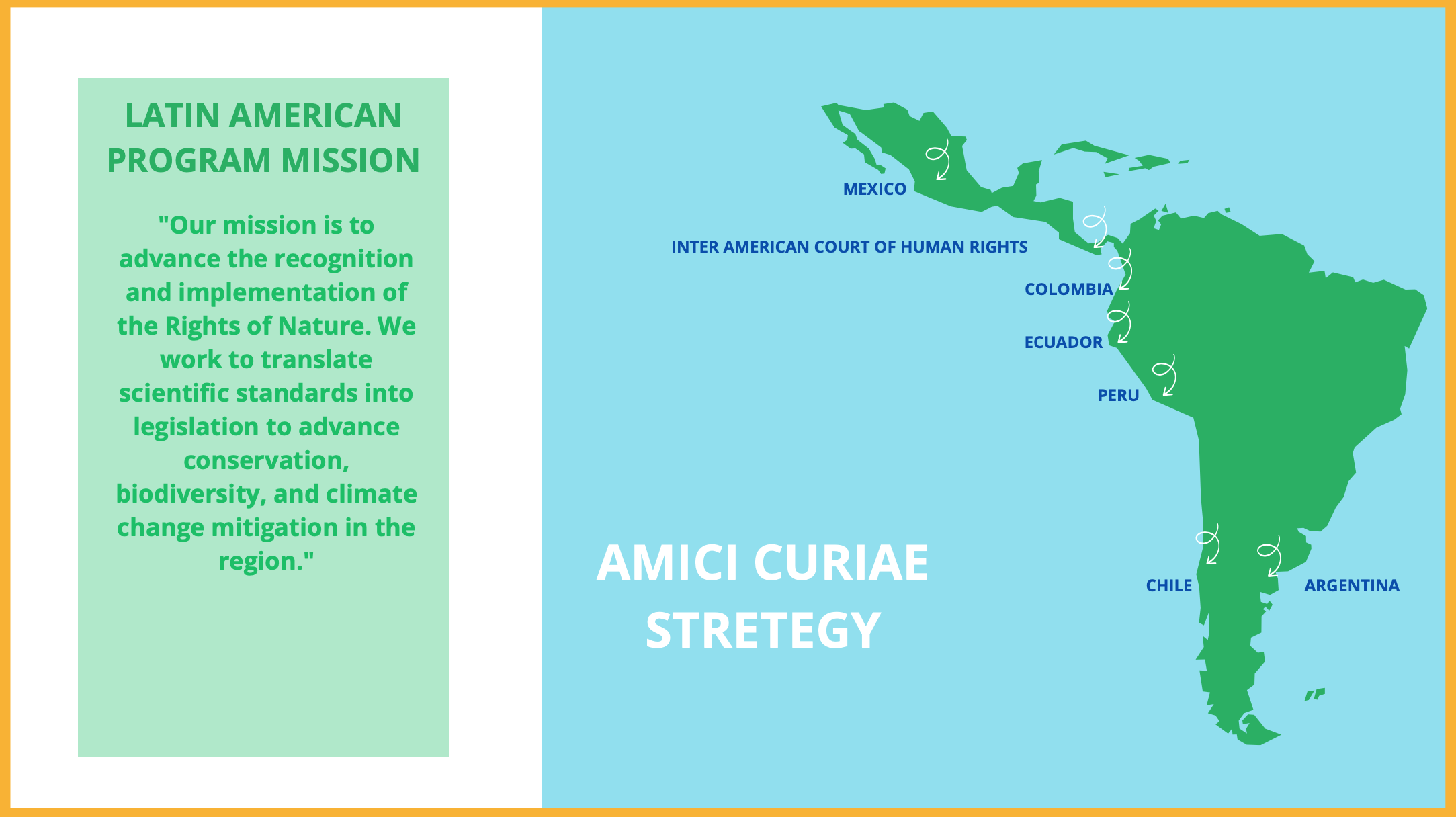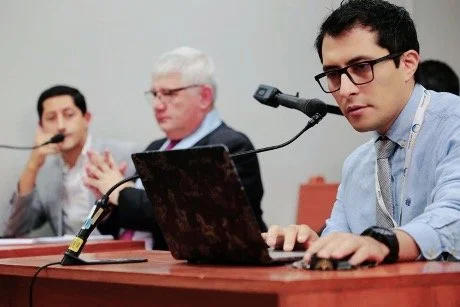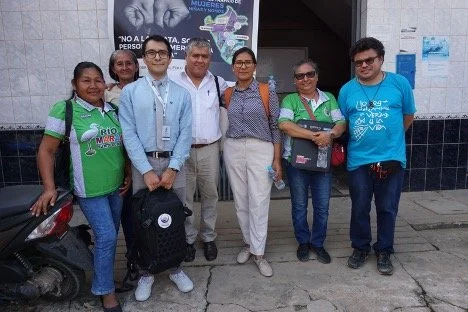ELC’s Latin America Program Advances Rights of Nature Strategic Litigation via Amicus Curiae Briefs
“Earth Law Center’s Latin America team drafts amicus curiae briefs on the Rights of Nature as a tool to cross-pollinate Latin American courts with the ecocentric perspectives of comparative law and supranational courts. Judges have been great allies in adopting a more progressive interpretation of existing regulations, allowing the recognition of the Rights of Nature and the incorporation of Nature’s intrinsic value.”—Constanza Prieto Figelist, Earth Law Center Latin America Legal Director
Although the Rights of Nature movement remains comparatively small, it is one of the fastest growing environmental legal movements in the world. Courts of justice have played a leading and essential role in the recognition of the Rights of Nature, advancing progressive interpretations that have opened the door to the adoption and implementation of ecocentric legal frameworks for environmental decision-making in multiple latitudes.
Worldwide, nearly 150 judicial cases have recognized the Rights of Nature. Among many others, there are the cases of the Atrato River (2016) and the Amazon (2017) in Colombia, the Marañón River in Peru (2024), and the Advisory Opinion of the Inter-American Court of Human Rights OC 23/17 (2017). In many of these cases, amicus curiae (friend of the court briefs, sometimes referred to as amici curiae when plural) have been crucial in decision-making.
Screen shot from Eco Jurisprudence Monitor
The Rights of Nature legal movement entails the development and propagation of a new legal paradigm, or at the very least new normative interpretations of environmental laws. To achieve this goal will require a decades-long collective social effort and a process of decanting new moral, social, and cultural agreements. The participation of various civil society actors including activists, lawyers, academics, scientists, leaders of Indigenous Peoples, judges, governments, and international organizations is needed to produce this transformation. One of the strategies Earth Law Center (ELC) has adopted to achieve this goal is to have an extensive presence in environmental court cases in Latin America through the presentation of amicus curiae.
One of the pillars of the Latin America Program’s work has been promoting and defending environmental justice and the Rights of Nature in the judicial field. ELC advises local communities and organizations and offers its expert opinion through amicus curiae briefs in lawsuits. We especially work to provide such briefs in cases that seek to guarantee the Rights of Nature or environmental rights of communities, Indigenous Peoples, and the rights of present and future generations.
Traditionally, in judicial processes, the interests of communities, governments, and private individuals are represented, while non-human natural entities enjoy no representation whatsoever. In our amicus curiae, we draw on comparative law, scientific standards, supranational court decisions, and recommendations of international organizations to encourage courts to adopt a preventative perspective (erring on the side of preventing harm to Nature) and consider the intrinsic value of Nature in environmental decision-making. We thus help give voice to ecosystems in the judicial field.
And just as we draw on useful legal theories and precedents in drafting our legal opinions, our amicus curiae briefs have in turn served to pollinate comparative legal perspectives and criteria adopted by supranational courts, helping judges support decisions with highly innovative content.
ELC’s F. Javier Ruiz, Expert in Environmental Policy and Climate Change, defending our amicus brief in the case that recognized the rights of the Marañon River in Peru.
Since 2018, ELC has filed more than 20 amici curiae briefs in courts in the United States and in various countries in South America, Central America, and the Caribbean. We are proud to have offered expert opinion in this way to victorious Rights of Nature cases that are quickly becoming emblematic in the movement, such as the Los Cedros Protective Forest, the Dulcepamba River, and the Mangroves of Ecuador. Especially relevant has been our expert opinion in the cases of the Salado and Atoyac Rivers of Mexico (2019) and, most recently, the Marañón River in Peru (2024), in which the courts expressly cited the ELC’s amicus curiae briefs and echoed our language in their rulings.
Amicus curiae briefs: their history and role as a mechanism for citizen participation
Amicus curiae briefs are technical and specialized reports that can be presented in litigation on matters relevant to the case under discussion. These writings are typically presented by people or organizations who are experts in certain areas of knowledge. Although they are not party to the litigation, they intervene because they have a general interest in it. Common examples in which one sees amicus curiae presented include environmental, human rights, religious freedom, same-sex marriage, and abortion cases. The presentation of these writings aims to provide arguments for the resolution of a case. The opinions can be legal, scientific, anthropological, or from other vantage points. The recommendations made through amicus curiae briefs are not binding on judges, who can decide whether to consider them for the decision of the specific court case.
In the judicial tradition, amicus curiae originated in Roman law, wherein judges consulted those people who were considered prominent lawyers or experts in a particular area.[1] During the following centuries, the practice of consulting experts to better understand how to resolve a case spread to the Anglo-Saxon countries of common law legal systems and later extended to Romano-Germanic-based regulatory systems.[2]
Amicus curiae can be considered a procedural institution. The legal framework of each country establishes different rules by which interested parties can participate as friends of the court. Certain countries, such as Ecuador, employ very liberal parameters for participation. Others with more stringent requirements or limitations include the United States and Argentina.
In environmental matters, Principle 10 of the Rio Declaration on Environment and Development, which was drafted in 1992 and has been signed by over 175 countries, supports the possibility of presenting an amicus curiae brief: “States should facilitate and encourage public awareness and participation by making information available to all. Effective access to judicial and administrative procedures, including compensation for damages and relevant remedies, must be provided [emphasis added].”
The amicus curiae is a valuable tool that favors citizen participation, democratization, and transparency of the jurisdiction, guaranteeing the full validity of due process and human rights. This tool gives judges an additional perspective regarding the topics and arguments debated.[3] For ELC, it represents an educational opportunity to advance ecocentric interpretations and give Nature a voice in court.
The impact of amicus curiae briefs
The impact of amici curiae has been increasing as their use has become more popular, reaching a peak in recent decades. For instance, a 2020 law article notes the following about the use of amici curiae at the United States Supreme Court. “Over ten terms, amici cumulatively filed more than 8,000 briefs, participated in 96 percent of all argued cases, and were cited by the justices in more than half of their rulings. . . . In many ways, the last term was emblematic of modern Supreme Court amicus practice. The 2019-’20 term had more than 900 amicus briefs filed in argued cases, the highest average number of amicus briefs per case ever. The justices cited briefs in 65 percent of cases—another record—relying on friends of the court for perspectives on government policies, history, religion, medicine, psychology, and even the financial implications of the court’s decisions.”[4]
Research on the impact of amicus curiae briefs in the United States Supreme Court indicates that their presence increases the likelihood that certiorari (review procedure) will be granted and influences a litigant’s success on the merits.[5] Experts maintain that amicus curiae briefs can increase the success of litigation because they can indicate to the court that a wide variety of people outside the lawsuit will be affected by the court’s decision. Therefore, this hypothesis holds that, regardless of the social scientific, legal, or political information in the reports, the number of organizations present in a report is likely influence the Court’s decision. It is also argued that amicus curiae briefs are effective because they provide litigants with additional social, scientific, legal, or political information to support their arguments.[6]
In Latin America, there are no such evident statistical studies about the increase and impact of amicus curiae on litigation results. Our own experience, and that of our allies, as litigants, however, supports its incremental use and effectiveness.
“Strategic constitutional litigation is a tool that Indigenous organizations use to protect their rights against all types of extractive projects that benefit private interests,” said Maritza Quispe, the plaintiff lawyer in the Marañón River case. “Lawyers from the human rights movement also use this litigation to question the legality of certain legal norms that violate constitutional and conventional rights. However, this type of litigation is made up of a long series of stages; during these years of litigation, we have noticed that the amicus curiae briefs have become a fundamental tool because they provide those pursuing justice operators with specialized and technical information on relevant aspects related to a case that is being processed in the judicial system.”
Lawyers F. Javier Ruiz (ELC), Juan Carlos Ruiz (Instituto defensa Legal), and Maritza Quispe (Instituto defensa Legal), accompanied by River Marañón defenders.
For the case of the Los Cedros Protective Forest, which was resolved by the Constitutional Court of Ecuador, more than 50 amici curiae were presented at the public hearing on October 19, 2020. Some of these briefs were relevant for providing technical information to the judges; for example, a scientific amicus brief described the group taxonomy of the endemic orchids of the Protective Forest. Another brief presented the opinion of the residents of the Magdalena Alto community, who communicated to the court that the forest supplies clean water to more than 12 communities, and that their water supplies could be contaminated by mining activities proposed in the the Los Cedros.[7]
When Colombia and Chile requested an advisory opinion on the climate emergency and human rights from the Inter-American Court of Human Rights, more than 100 observations were presented, issued, and signed by states, institutions, state bodies, bodies of the Organization of American States, international bodies and organizations, non-governmental organizations, companies, academic institutions, people from civil society, and communities. Due to the universal and pressing importance of the climate emergency and the large number of observations that can be considered amicus curiae briefs, the Presidency of the Inter-American Court ordered oral hearings to be held between April and May 2024, convening the amici curiae to plead their arguments.[8]
In matters of the Rights of Nature, amicus curiae briefs have been key in guiding judges on the content and scope of these new rights and the principles of environmental law that are interrelated to guarantee them. For example, in the case that recognized the Marañón River as a subject of rights, ELC specialized in arguments about the Rights of Nature, including how the Marañón River could be recognized as a subject of rights through the application of the Advisory opinion of the jurisprudence of the Inter-American Court,[9] a criterion that was ultimately accepted by the Mixed Court of Nauta.
“The institution of the amicus curiae is an innovative tool that can greatly support judges in processes that resolve issues of great impact on society, such as human rights and the Rights of Nature,” said Javier Ruiz, the ELC Expert in Environmental Policy and Climate Change. “Having a technical opinion on a developing matter can guide a judicial decision favoring Nature and its components.”
Citations
[1]Salinas Ruiz, José de J. “Amicus curiae: institución robusta en Inglaterra y Estados Unidos, incipiente en México”, pp. 11-12.
[2]Ombudsman´s Office, El amicus curiae: ¿qué es y para qué sirve? Jurisprudencia y labor de la Defensoría del Pueblo, Serie Documentos Defensoriales - Documento N° 8, p. 23.
[3]Op. cit., pp. 38-39.
[4]Franze, Anthony J. and Anderson R. Reeves, The National Law Journal, Amicus Curiae at the Supreme Court: Last Term and the Decade in Review, November 18, 2020, p.1.
[5]Paul M. Collins Jr., Friends of the Court: Examining the Influence of Amicus Curiae Participation in U.S. Supreme Court Litigation, 38 LAW & SOC'y REV. 807 (2004). P. 807.
[6]Op. cit., p.808.
[7]Constitutional Court of Ecuador, Ruling No. 1149-19-JP/21, Judge Agustín Grijalva Jimenéz. Quito D.M., November 10, 2021. Available at: http://esacc.corteconstitucional.gob.ec/storage/api/v1/10_DWL_FL/e2NhcnBldGE6J3RyYW1pdGUnLCB1dWlkOic2MmE3MmIxNy1hMzE4LTQyZmMtYjJkOS1mYzYzNWE5ZTAwNGYucGRmJ30=.
[8]Inter-American Court of Human Rights, Resolution of the Chair. Request for Advisory Opinion OC-32 Submitted by the Republic of Chile and the Republic of Colombia on the Climate Emergency and Human Rights, February 22, 2024. Available at: https://corteidh.or.cr/docs/asuntos/solicitud_22_02_2024_spa.pdf.
[9]Mixed Court of Nauta I, Case 00010-2022-0-1901-JM-CI-01 Amparo Action. Judgment of March 8, 2024.




